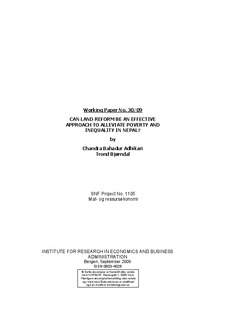| dc.contributor.author | Adhikari, Chandra Bahadur | |
| dc.contributor.author | Bjørndal, Trond | |
| dc.date.accessioned | 2009-10-22T12:20:30Z | |
| dc.date.available | 2009-10-22T12:20:30Z | |
| dc.date.issued | 2009-09 | |
| dc.identifier.issn | 1503-2140 | |
| dc.identifier.uri | http://hdl.handle.net/11250/166240 | |
| dc.description.abstract | Land is the main source of income and consumption for the Nepalese people. This study analyses the economic relationship between access to land and poverty in Nepal by establishing the link between land and consumption as well as land and income. A generalised additive model (GAM) and ordinary least squares (OLS) demonstrate that greater access to land for the poor increases income and consumption and thereby reduces poverty. The significant marginal value of land for both consumption and income implies that an effective land reform policy could well be the most effective approach to alleviate rural poverty. However, land reform must come as part of a larger overhaul. Cluster analysis shows that land reform should target appropriate subgroups within the community in order to differentiate those who would make use of the extra land from those who would not, and apply appropriate strategies to each subgroup. It reveals the importance of subgroups in determining an appropriate strategy for tackling poverty. Three distinct groups are found within our dataset that explain most of the variation. | en |
| dc.language.iso | eng | en |
| dc.publisher | SNF | en |
| dc.relation.ispartofseries | Working paper | en |
| dc.relation.ispartofseries | 2009:30 | en |
| dc.subject | poverty | en |
| dc.subject | access to land | en |
| dc.subject | land reform | en |
| dc.subject | Nepal | en |
| dc.title | Can land reform be an effective approach to alleviate poverty and inequality in Nepal? | en |
| dc.type | Working paper | en |
| dc.subject.nsi | VDP::Samfunnsvitenskap: 200::Økonomi: 210::Samfunnsøkonomi: 212 | en |
